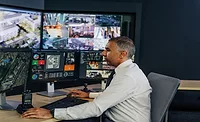A Layered Approach to Keeping Campuses Safe

University and college campuses are changing. The increase in ride-share and food delivery services means that there are more unauthorized and unidentified people accessing these spaces than ever before. While these services provide tremendous benefits to the university population, they can also raise security concerns.
At one end of the spectrum, they can cause nuisance and logistical issues. But, at the other end, they can provide the means and opportunity for dangerous individuals to engage in unlawful acts. From breaking and entering to assault and kidnapping, allowing unauthorized people free access to campus communities can endanger staff and students and negatively impact the learning environment.
A good approach to these concerns is to think about integrated concentric circles of security. Automatic license plate recognition (ALPR) systems at the perimeter can identify both known and unknown vehicles accessing the campus. Video surveillance systems and analytics can help security personnel identify individuals, gather actionable intelligence and investigate after the fact. And access control systems (ACS) can ensure that unauthorized individuals do not access restricted spaces.
Ride-share Programs Bring More Vehicles to Campus
One of the new challenges being faced by colleges and universities is the influx of vehicles. Between Thursday afternoon and Sunday morning, the number of ride-share vehicles coming onto campus increases dramatically. Depending on the layout of roads and walkways, this increased traffic can cause congestion as drivers wait for passengers in zones that are frequently not designated for pick-up or drop-off. And the increased traffic can also cause accidents as people and vehicles occupy the space in a new way.
But a more serious challenge is protecting against drivers using a fake ride-share ID. Students are left vulnerable if there is no way to identify and track vehicles coming onto campus. Having a better understanding of who is coming onto the campus can help security personnel and administrators ensure the safety of their student population.
By installing an ALPR system at campus entrances, security personnel can be alerted when a scofflaw or blacklisted vehicle enters the area. It can also help identify non-campus associated vehicles and potentially verify authentic ride-share drivers. And, when video is associated with ALPR data, security personnel can forensically track vehicles involved in accidents, as well as those used in cases of theft, kidnapping, or assault.
What Happens When Food is Delivered to the Dorms?
Another challenge stems from the increase in food delivery services. Today, many colleges and universities offer declining balance cards that allow students to order food from businesses off-campus. As a result, food delivery people are regularly coming on campus and into dorm buildings. It’s part of their job to bang on doors and ask students to open up. This means that, if they want to, they can get a sense of which doors are frequently left open or which rooms are always empty.
One way to track the movement of food delivery drivers on campus is through video surveillance. When integrated with analytics, video surveillance can provide security personnel with the situational awareness they need to be able to resolve incidents quickly and effectively. The data collected can also be vital for after-incident investigations in order to identify perpetrators and determine exactly what happened.
Why are Campuses Vulnerable to Theft?
Colleges and universities are also experiencing a rise in theft. And the nature of campuses themselves are contributing to the problem.
First, these environments are often regarded as technology and wealth centers. In addition, they function on set schedules that include long periods with relatively few people around. This combination makes campus areas, particularly parking lots and dorm rooms, easy targets for theft.
Integrating video surveillance with an ACS can help security personnel identify and track unauthorized people on campus. This integration can allow them to verify who is interacting with their systems within and around buildings. And, with the right system, they can also bookmark video clips, making it easier to search through data during an investigation.
Security That’s There When You Need it
The challenge is creating a safe space without turning it into a police state. Students, faculty and staff must be able to work and learn in an open and welcoming environment. This means that, in order to be successful, the physical security system must exist in the background. It should not be seen until it needs to be seen.
Campus security teams routinely provide programs for students aimed at encouraging them to be careful. They advise students to pay careful attention to driver IDs, keep their dorm rooms locked, refrain from leaving items in their cars and close their windows and blinds when they go on vacation. Now, campuses can also add security technology in the background that helps them preventatively and forensically keep their campuses safe.
Looking for a reprint of this article?
From high-res PDFs to custom plaques, order your copy today!





.webp?height=200&t=1686342393&width=200)


